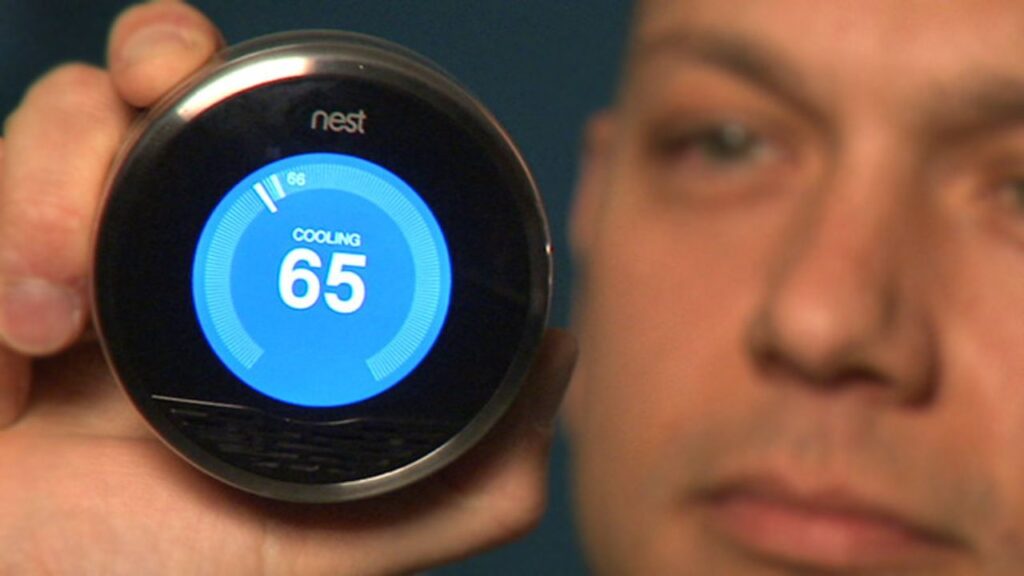Why Is My Google Nest Cooling So Slow? Your Google Nest thermostat may be cooling slowly due to Wi-Fi connectivity issues, thermostat settings, or HVAC system compatibility problems.
Google Nest devices have changed how we control our home’s heating and cooling systems, making it easier, more energy-efficient, and more convenient.
But users may sometimes have problems where the cooling process takes longer than thought.
It’s important to make sure that your Nest is working at its best, whether you’re trying to cool your home in the summer or guarantee that the temperature stays warm.
It can be uncomfortable and cost more to cool your home if your Google Nest thermostat is set to cool it slowly. [Why Is My Google Nest Cooling So Slow?]
We’ll talk about the possible causes of slow cooling, how to fix the problem, and when you should call a professional in this blog post.
How does Google Nest work?
As part of the smart home revolution, Google Nest thermostats let users handle their heating, ventilation, and air conditioning (HVAC) systems from a smartphone or tablet.
The thermostat learns from how you use it and adjusts the heating and cooling to work best for you based on your plan and preferences. [Why Is My Google Nest Cooling So Slow?]
Changing the temperature when you’re not home or when the house is already at a comfortable level is how Nest tries to save energy.
This gadget connects to your HVAC system and tells your air conditioner how to cool or heat your home. It’s important for the Nest thermostat and your HVAC system to be able to talk to each other.
If there is a problem with this connection, it could lead to problems like cooling that takes too long or using too much energy.
Why Things Might Be Cooling Down Slowly
There are several reasons why your Google Nest might not be cooling your home as quickly as you thought it would. Let’s look at each factor and how it can change the cooling process as a whole.
1. Problems connecting to Wi-Fi
One of the main reasons why a Google Nest thermostat might not cool as quickly as it should is that the Wi-Fi connection is weak or unstable.
Google Nest needs to be connected to Wi-Fi in order to talk to the HVAC system. This is especially true when using the remote control or the app to make changes to the settings.
If your Wi-Fi signal is weak, the thermostat might not be able to tell your air conditioner what to do properly. [Why Is My Google Nest Cooling So Slow?]
Wi-Fi problems can also happen if the network is too busy, if other devices are interfering, or if there are real obstacles in the way of the signal. If the Nest thermostat can’t keep a stable link, it might not work as well as it should.
2. Thermostat settings that are wrong
Sometimes, slow cooling is just because the temperature is set wrong. The system might not cool your home fast enough if it is set to the wrong mode, like “Heating” instead of “Cooling,” or if the temperature is too high.
Also, the cooling process may be delayed if the Nest is set to a plan that doesn’t work with your current needs, like a temperature that saves energy.
The temperature should be set to a level that lets your air conditioner work properly. Also, make sure that your Nest is in the right cooling mode. The problem might be fixed by making a few simple settings changes.
3. Compatibility with HVAC Systems
Smart heaters like Google Nest don’t always work well with HVAC systems. If your HVAC system is old or doesn’t work with some Nest features, it may cool down more slowly or use energy more efficiently.
Sometimes, the Nest and your HVAC system might not work well together. This could be because of bad wiring or a system that doesn’t have the right control features.
It’s important to make sure that the Google Nest thermostat can connect to your HVAC system. [Why Is My Google Nest Cooling So Slow?]
If problems with compatibility are found, you may need the help of a technician to make sure the installation and setup are done correctly.
4. Not enough power or battery
If your Google Nest thermostat’s battery is low or there isn’t enough power, it may work slowly. If the Nest isn’t getting enough power, it might not be able to talk to your HVAC system correctly.
This could cause the temperature to cool down slowly or not respond at all when you change the temperature.
The thermostat needs either battery power or a wired link to work right. If either isn’t present, the cooling process might not work as it should.
You should check your Nest’s battery level and make sure it is fully charged or hooked up to a power source that stays on all the time.
If the battery is low, you might have to change it to get the thermostat to work properly again. [Why Is My Google Nest Cooling So Slow?]
5. Air filters that are dirty or blocked
Air filters are an important part of keeping your HVAC system working well and moving air. If these filters are dirty or jammed, they can block airflow, which makes it harder for your air conditioner to cool the house.
The system has to work harder because of this, and the cooling process takes longer. Filters that are dirty also use more energy and can make the system overheat, which could cause it to stop working.
To keep your HVAC system going smoothly, you need to clean or replace your air filters on a regular basis. This easy maintenance job can make the cooling process work better and keep the system from getting worse.
6. Bad wiring or problems with the system
There are times when the problem could be with the wiring that connects your Google Nest thermostat to the HVAC system. [Why Is My Google Nest Cooling So Slow?]
Bad wiring can make it hard for the two devices to talk to each other, which can make the cooling less effective or even stop working altogether. This could be due to bad fitting, normal wear and tear, or wiring damage.
Also, problems with the HVAC system, like problems with the refrigerant, the compressor, or leaks, can make your air conditioning work less well.
The Nest thermostat won’t be able to effectively control the cooling process if the HVAC system isn’t working right. [Why Is My Google Nest Cooling So Slow?]
How to Fix Things That Are Slowing Down
If your Google Nest isn’t cooling your home properly, here are some things you can try before calling a professional. Here are the steps that should be taken:
Step 1: Make sure your Wi-Fi is connected
Step one is to make sure your Wi-Fi works. For remote control and talking to your HVAC system, Google Nest needs stable Wi-Fi more than anything else.
Make sure your Wi-Fi network is strong and that there aren’t any problems with interference, like networks that are too busy or things that are in the way of the signal.
To make the link stronger, move your router closer to the thermostat or buy a Wi-Fi extender if your signal is weak. [Why Is My Google Nest Cooling So Slow?]
Step 2: Look over the settings on your thermostat
Check your thermostat for a moment to make sure it’s set properly. Make sure the cooling mode is on and that the temperature you want is set to a reasonable amount. If your thermostat has a set time, make sure it fits with how much cooling you need right now. By changing these settings, you can get the thermostat to work right again.
Step 3: Make sure the HVAC system works with the house
It is very important to make sure that the Google Nest thermostat works with your HVAC system. If you’re not sure if something will work, check out the Nest support page or talk to a professional.
If your HVAC systems aren’t fully compatible with the Nest, they might not work as well as they should. Making sure that they are is very important for getting the best performance.
Step 4: Check the battery level
Check to see how much power your Nest gadget has left. The system may not respond as quickly if the power is low. [Why Is My Google Nest Cooling So Slow?]
Go to the Nest settings in the app or on the gadget itself to see how much power is left. If necessary, change the battery to get it working as well as it did before.
Step 5: Clean or change the air filters
Check and clean your HVAC air filters to make sure that air flows smoothly and that your air conditioner works well. If they are filled with dirt and dust, you should get new ones.
This easy repair task can make the cooling go faster and the system work better overall.
Step 6: Get help from a professional if your system isn’t working right
If none of the steps above fix the problem, you might need to get in touch with a professional. [Why Is My Google Nest Cooling So Slow?]
If your HVAC system isn’t working right, has problems with the wires, or the refrigerant, you need to get a technician to look at it and fix it.
Getting professional help makes sure that the problem is correctly identified and fixed.
When to Get Help from a Professional
Many problems with slow cooling can be fixed by doing some simple research, but some issues need to be fixed by a professional.
It’s best to call a professional if your HVAC system is old, broken, or doesn’t work with your Nest thermostat. [Why Is My Google Nest Cooling So Slow?]
A professional can look at the system, figure out what’s wrong, and make sure your Google Nest is working right.
If your Nest thermostat is having wiring issues or other technical problems, a professional can make sure it was installed correctly and get it working again.
Getting professional service will also help keep your thermostat or HVAC system from getting worse. [Why Is My Google Nest Cooling So Slow?]
See Also: Why Is Lil Wayne’s Face So Fat Now? Possible Reasons
In conclusion: Why Is My Google Nest Cooling So Slow?
If your Google Nest thermostat is cooling your home slowly, it doesn’t have to be a frustrating or long-lasting issue.
There are many things that could cause this problem, like Wi-Fi connection, thermostat settings, HVAC compatibility, low battery, dirty filters, or bad wiring.
If you know what those things are, you can take steps to fix the problem. Checking the battery level and cleaning the filters are two examples of regular care that can help keep your Nest working well.
If trying doesn’t fix the issue, you can always get help from a professional. You can get your Google Nest back to its best cooling performance and enjoy a comfy home with the right help.
FAQs
How do I make my Google Nest thermostat work again?
Pick up your Google Nest, go to the settings menu, and choose “Reset.” This will set the thermostat back to how it was when it was first made. After the reset, make sure to set it up again.
Why doesn’t my Google Nest cool down as fast as it should?
Problems like wrong settings, bad Wi-Fi connection, HVAC compatibility issues, or dirty air filters can all cause cooling to be slow. Go over your settings and first see if you’re having trouble connecting.
What should I do if my Nest thermostat isn’t communicating with my HVAC system?
Check the wires, see if there are any Wi-Fi problems, and make sure that Nest can connect to your HVAC system. Talk to a professional if the problems don’t go away. [Why Is My Google Nest Cooling So Slow?]
Can I fix the slow cooling issue on my own, or do I need professional help?
There are steps you can take to fix many problems, but if the issue is with your HVAC system or wiring, you may need to get help from an expert.
What do I do to change the battery in my Google Nest?
You can check the energy level in the app or in the settings of the device. If the battery is low, you can get it working again by replacing it with a suitable one. [Why Is My Google Nest Cooling So Slow?]

Hi, I’m Fernando Pham, and welcome to WhyDetails.com! I’m from San Francisco, and I love exploring questions and sharing answers through my blog.



